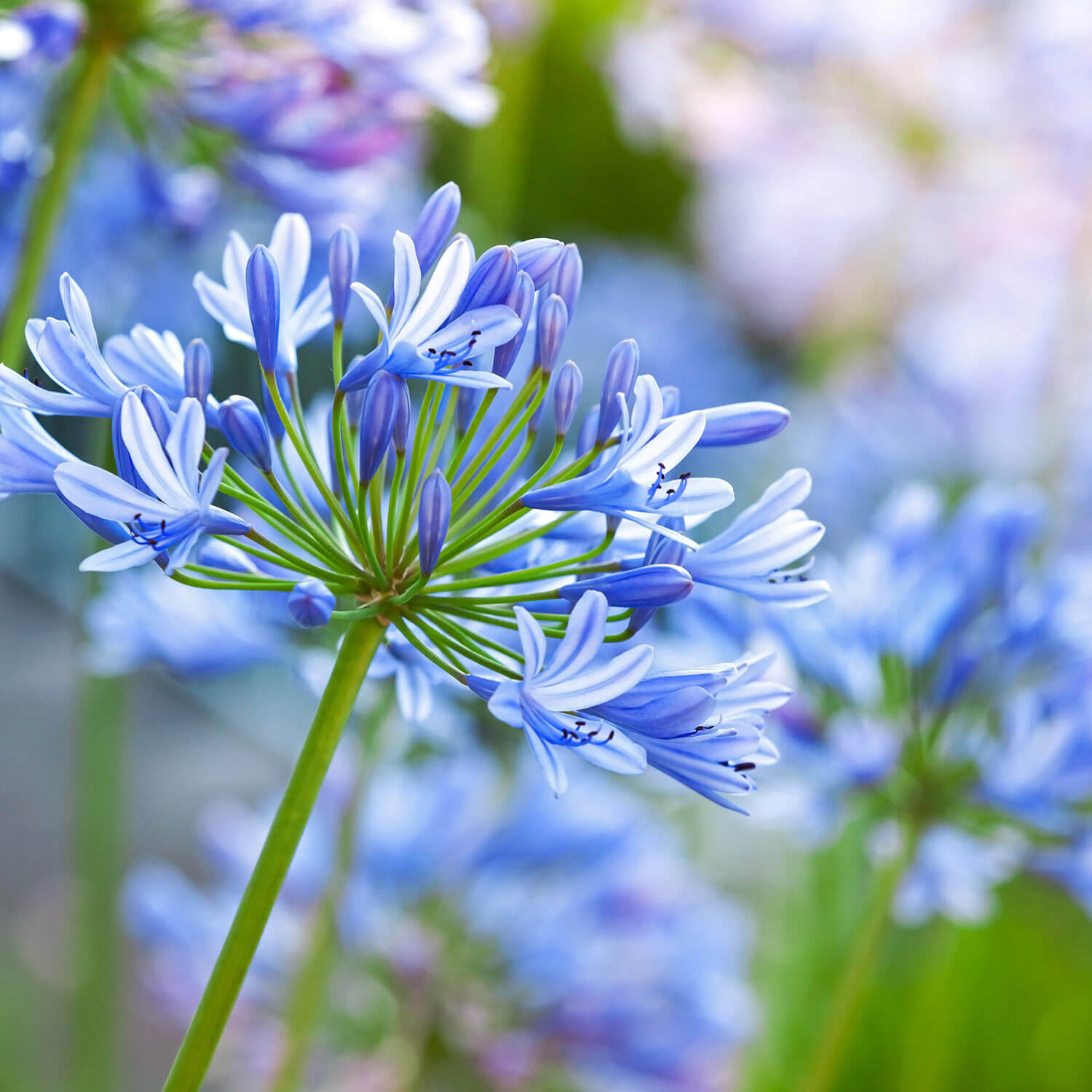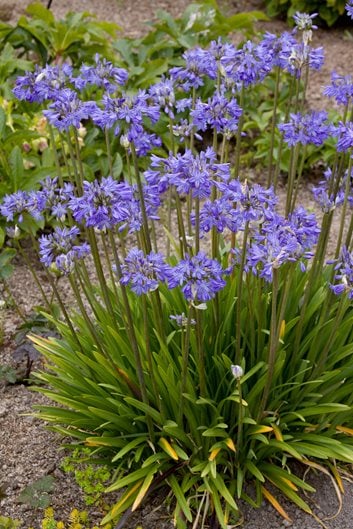Agapanthus Buddy Plant Kingdoms: Perfect Pairings for Your Yard
Agapanthus Buddy Plant Kingdoms: Perfect Pairings for Your Yard
Blog Article
Releasing the Secret to Effective Agapanthus Cultivation: Idea for a Flourishing Garden
In the realm of horticulture, growing agapanthus efficiently needs a strategic method that incorporates various elements of plant treatment. With mindful focus to information, one can open the secrets to supporting these stunning blooms, bring about a garden that flourishes with charm and vibrancy. By recognizing the subtleties of agapanthus cultivation, one can develop an environment where these plants flourish and bloom generously. In the following conversation, we will discover important ideas and methods that will certainly direct you towards a growing agapanthus garden, using understandings right into ideal practices, soil problems, watering strategies, and much more.
Planting Agapanthus: Best Practices
When growing Agapanthus, appropriate dirt prep work is vital for making sure successful growth and advancement of these beautiful flowers. Agapanthus, generally known as Lily of the Nile or African lily, flourishes in well-draining dirt with a slightly acidic to neutral pH degree - Agapanthus. Prior to planting, it is essential to change hefty clay dirts with raw material such as compost or peat moss to improve drain and supply essential nutrients for the plants
To plant Agapanthus, choose an area that gets full sunlight to partial color, as this will certainly advertise healthy and balanced growth and abundant blooming. Dig a hole twice the diameter of the plant's root ball and place the Agapanthus at the same depth it was previously growing. Delicately backfill the hole with dirt, pressing down firmly to remove any type of air pockets around the roots.
Water the freshly planted Agapanthus extensively and proceed to keep the soil uniformly damp, particularly throughout the plant's energetic growing season. Agapanthus. Applying a well balanced plant food once a month can even more sustain the plant's development and blooming. By complying with these ideal techniques for planting Agapanthus, you can develop a stunning screen of these fascinating flowers in your yard
Suitable Soil Issues for Agapanthus
For optimum growth and growing success of Agapanthus plants, ensuring the dirt conditions are excellent is important. Agapanthus prefers dirt that is rich in nutrients, so integrating a well balanced fertilizer throughout the expanding period can promote healthy growth and lively blossoms.

Watering and Fertilizing Tips
To make certain healthy and balanced development and vivid flowers, proper watering and fertilizing methods are essential for successful Agapanthus cultivation. Agapanthus plants profit from routine watering, especially during the growing period. It is recommended to water deeply when a week, making certain the soil is wet yet not saturated. Throughout hot weather or in pots, more constant watering may be required to stop the soil from drying totally.
When it concerns feeding Agapanthus, a balanced plant food with equivalent components nitrogen, phosphorus, and potassium can be used in the spring to advertise healthy and click this link balanced development and blooming. Slow-release plant foods are optimal for supplying nutrients slowly over an extensive period. Prevent over-fertilizing, as this can cause extreme vegetation development at the expense of blossoms.
Additionally, incorporating organic matter like garden compost into the soil can boost nutrient degrees and improve dirt structure, helping in the total wellness of the Agapanthus plants. By complying with these watering and feeding suggestions, gardeners can guarantee their Agapanthus plants prosper and generate stunning display screens of blossoms.
Pruning and Deadheading Techniques
Proper pruning and deadheading strategies play a critical function in keeping the wellness and looks of Agapanthus plants, matching the necessary practices of watering and fertilizing for effective farming. Pruning Agapanthus includes getting rid of spent blossom heads, yellowing or dead leaves, and general shaping of the plant to promote far better development. Deadheading, the process of getting rid of discolored blossoms, not just boosts the plant's look however also urges more flowering.
When deadheading Agapanthus, it is advisable to trim off the blossom stem at the base making use of sharp, tidy shears. This procedure redirects the plant's energy from seed production back right into root and foliage growth, promoting a much healthier and more durable plant. Normal deadheading can expand the blooming period of Agapanthus and avoid self-seeding, which can bring about overcrowding.
In terms of pruning, Agapanthus generally gain from a light trim after blooming to clean up the plant and urge fresh growth. Reducing back the invested flower stems and removing any type of dead or broken vegetation assists preserve the plant's vigor and general appearance. top article Nevertheless, it is important to avoid reducing right into the crown of the plant, as this can deteriorate its health and wellness.

Protecting Agapanthus From Vermins and Diseases
Implementing reliable insect and disease management techniques is important to guarding the health and wellness and vitality of Agapanthus plants in farming. Agapanthus are generally durable plants, yet they can still come down with numerous bugs and conditions if not appropriately taken care of. One common pest that impacts Agapanthus is the Agapanthus borer, a caterpillar that passages into the plant, creating damages to the flowers and leaves. To prevent invasions, regular inspection of the plants is crucial. If borers are identified, they can be manually eliminated, or insecticidal soap can be utilized as a control action.
In enhancement to pests, Agapanthus are vulnerable to conditions such as root rot and fungal leaf areas. These problems can usually be protected against by making sure proper drain and staying clear of overwatering. If indicators of illness show up, impacted components of the plant ought to be immediately removed to protect against further spread. Fungicides might likewise be made use of as a treatment action, following the maker's directions meticulously. By remaining vigilant and addressing bug and disease issues promptly, garden enthusiasts can assist their Agapanthus thrive and prosper.

Conclusion
To conclude, successful cultivation of agapanthus calls for proper growing methods, excellent dirt problems, appropriate watering and fertilizing, regular trimming and deadheading, and security from illness and bugs. By adhering to these tips and tricks, gardeners can make certain a flourishing garden loaded with stunning agapanthus flowers. Agapanthus. Remember to keep constant care and focus to information to promote the wellness and long life of these magnificent plants
When planting Agapanthus, appropriate dirt preparation is important for guaranteeing effective development and development of these stunning blossoms.Water the freshly planted Agapanthus completely and continue to maintain the soil equally damp, particularly throughout the plant's energetic expanding period.For ideal growth and growing success of Agapanthus plants, guaranteeing the dirt conditions are excellent is critical. When planting or transplanting Agapanthus, make sure her comment is here the soil is well-prepared to give the required structure for the plants to establish themselves efficiently. One typical insect that influences Agapanthus is the Agapanthus borer, a caterpillar that passages into the plant, triggering damage to the fallen leaves and flowers.
Report this page